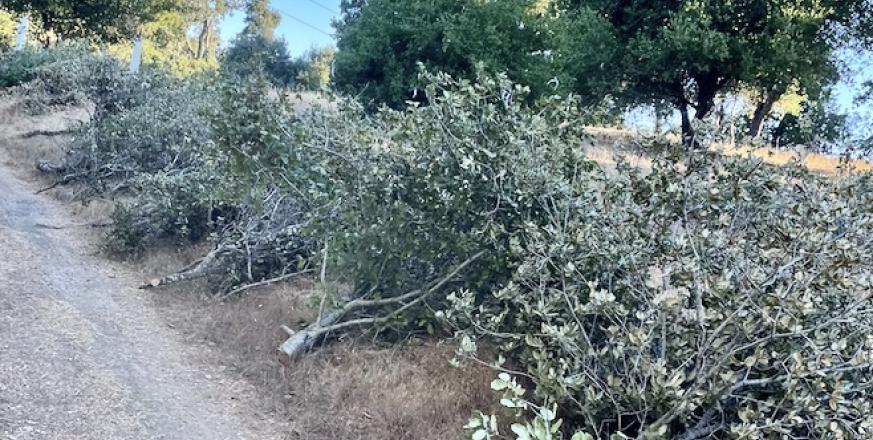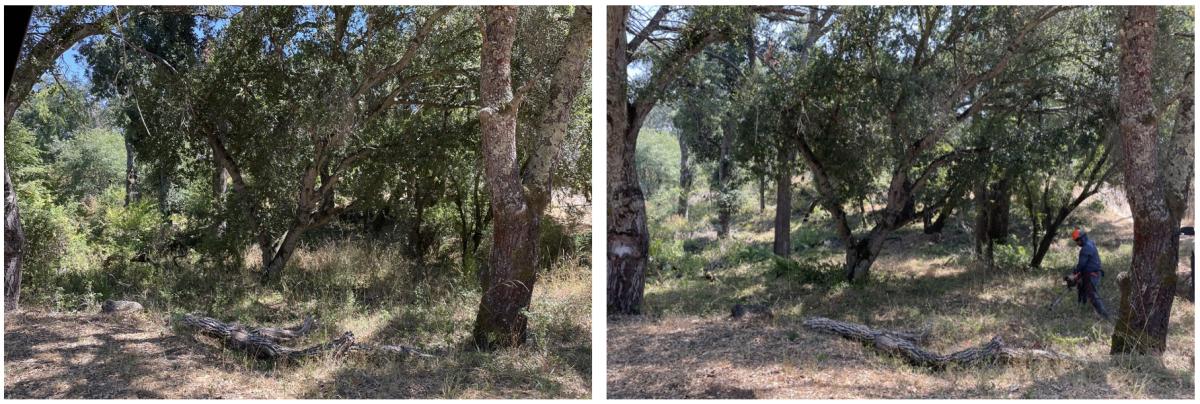Summer 2023 Wildfire Fuel Reduction at Jasper Ridge

Branches that were later chipped by the fuel reduction consultants after limbing up and thinning treatments that created a shaded fire break inside the perimeter of the preserve along Sand Hill Road.
This summer, staff at Jasper Ridge Biological Preserve did their part to mitigate wildfire risk by reducing fuel across approximately 80 acres of the preserve. These high-priority areas were identified through the 2021 Stanford Wildfire Management Plan, a comprehensive plan that models wildfire risk and outlines fuel reduction efforts across all Stanford University lands.
Consistent with Jasper Ridge’s mission of research, education, conservation, and environmental stewardship on this land, it is important to consider ecological principles and protection of existing long-term research projects when planning and implementing fuel reduction treatments. These goals were outlined in the Jasper Ridge white paper that was developed by 25 experts in the areas of wildfire modeling, fire emergency response, land management, risk management, indigenous practice, research, education, policymaking, law and ecology through the Fire Fuels Ecology Workshop hosted at Jasper Ridge in Spring 2022.
To meet Jasper Ridge’s specific goals and plan our fuel reduction, staff worked with partners across the university, including Land Buildings and Real Estate (LBRE), University Fire Marshal (SUFMO), and fuel reduction consultants. The fuel reduction prescription was first tested in a “preview plot” on 1.5 acres just south of the main entrance gate in order to evaluate and define the best fuel reduction approach combined with wildlife monitoring efforts. Following the test, a low-impact hand treatment, including hand crews using chainsaws, with broadcast chipping was applied to most of the oak woodland area along Sand Hill Road and Westridge boundary to create a shaded fuel break extending 200-300ft into the preserve from the fence line with the most fuel removed within the first 100ft. Jasper Ridge staff worked closely with the contractor crew to train, monitor, and iteratively modify the fuel reduction treatment to meet our goals (Figure 1). This handwork was then supplemented by a few areas of mastication work where poison oak or terrain made it a safer option.

Some fuel-reduction treatment areas along the Westridge boundary also included chaparral. Here, Jasper Ridge staff identified an excellent opportunity to utilize pile burns as an additional fuel-reduction tool (Figure 2). Working with NWGC qualified Prescribed Burn Boss, Phil Dye of Prometheus Fire Consulting, Jasper Ridge will be developing a pile burn plan to take the first small step in introducing fire for both wildfire risk mitigation and ecological stewardship of the preserve. This burn plan (tentatively scheduled for early 2024) will be developed with support of both CAL FIRE and Woodside Fire Protection District who have visited and advised on the site. See related article from Stanford Report, Jasper Ridge Biological Preserve's wildfire management efforts are piling up (October 20, 2023).
With all the progress made this year in fuel reduction at Jasper Ridge Biological Preserve, it should be noted that this is not a “one-time deal.” Fuel reduction efforts require ongoing maintenance in order to remain effective. This is where our strengths of science and research will have their greatest impact. Jasper Ridge staff have established research and monitoring plots to track ecological changes in the fuel reduction area, paired with control plots. Similar plots have also been established by LBRE’s Conservation Program throughout the rest of Stanford lands. As these plots are monitored over time, Stanford land managers will be able to use this information to develop an adaptive management strategy and inform future maintenance plans. Plans may include goat grazing, mowing, or other low-impact hand treatments. Additionally, Jasper Ridge has been in contact with Dr. Laura Jones, Director of Heritage Services and University Archaeologist, and Dr. Michael Wilcox, Tribal Historic Preservation Officer for the Muwekma Ohlone Tribe of the San Francisco Bay Area, to invite the Muwekma Ohlone Tribe to participate in these new stewardship activities.
Jasper Ridge Biological Preserve’s pillars of education, research, and stewardship continue to be supported by faculty, staff, and students who are interested in developing research projects to explore the impacts and benefits of ecologically sensitive fuel reduction (as featured here and here). With wildfires a serious threat across California, Jasper Ridge Biological Preserve, as an academic unit of the School of Humanities and Sciences, is committed to mitigating risk on its land, sharing best practices with local and regional partners, and contributing to a better understanding of ecological stewardship. See related article from Stanford Report, Jasper Ridge Biological Preserve's wildfire management efforts are piling up (October 20, 2023).




